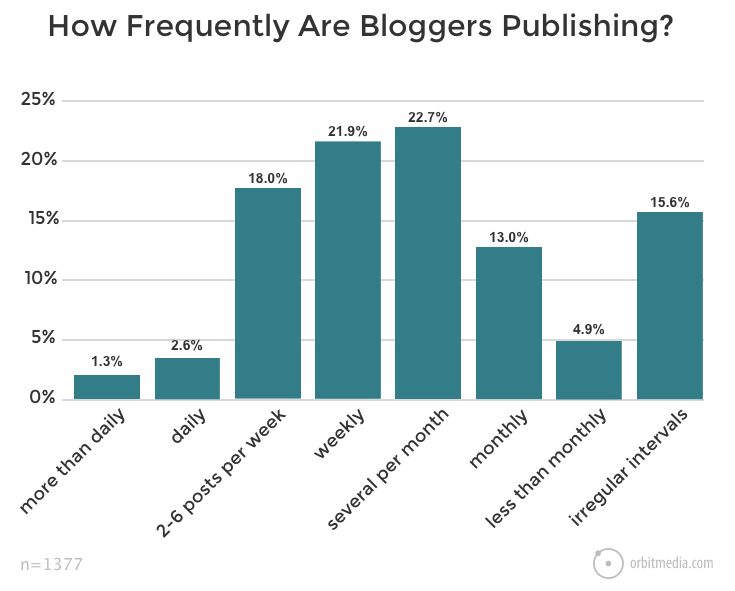The problem is people writing blog posts don’t know why their blogs don’t help them convert their readers. Here’s how often the average blogger publishes posts on their website: As you can see, the majority of websites publish a new post on a weekly basis or at least several times per month. You’re writing a post for a blog. This strategy is highly effective if you’re directing your readers to do something: That’s because visual content is easier for most of your readers to understand. As a result, you’ll get higher conversions. Only 16% of people read blog posts word for word—79% of readers scan it. How can your readers know what action you want them to take if even you don’t know what you want them to do? You add a blog to your website to try to get even more conversions. If they click on your posts after a search, you’ll increase your chances of getting more conversions. Your blog posts need to be mobile-friendly.
Blogging is one of my favorite marketing tools. There are many benefits to blogging—that’s why all my websites have blogs.
But honestly, I enjoy it as well. Writing blog posts keeps your finger on the pulse and helps you stay connected with your audience. I’m not saying you have to be in love with it, but it definitely makes things easier if you like to write.
If you take care of your blog, your blog will take care of you in return.
Those of you who have a blog up and running are headed in the right direction. But if your posts are not generating leads or getting readers to convert, it’s a problem.
First, it’s a waste of your time. Think about all the time and effort you put into these posts. If nobody’s reading them or converting, you’d almost be better off not writing at all.
Second, it’s a huge missed opportunity. Blogging is basically free marketing. The only cost to you is your time writing.
If you can learn how to write content that converts, you’ll have a huge return on your investment.
The problem is people writing blog posts don’t know why their blogs don’t help them convert their readers. If this sounds like you, you’ll definitely benefit from this guide.
I’ve outlined how you can identify the elements, or lack thereof, on your blog that are crushing your conversion rates.
Once you recognize the problems, it should be an easy fix. Here are the factors you need to keep an eye on.
Infrequent posts
You can’t expect high conversion rates if you’re not constantly posting new content on your blog. Those of you posting only once or twice a month need to step up your game.
Here’s how often the average blogger publishes posts on their website:

As you can see, the majority of websites publish a new post on a weekly basis or at least several times per month. That must be the best approach, right? Think again.
Although there is a higher percentage of bloggers posting at this frequency, it doesn’t mean it’s the best option.
In fact, 66.7% percent of bloggers who publish content more than once per day report strong results based on this frequency. Only 31.5% of bloggers who post on a weekly basis feel the same way.
So for the most part, it’s safe to say the more often you post, the better your conversions will be.
On average, it took bloggers 3 hours and 20 minutes to write a blog post in 2017. I’m not saying that’s fast, but it really isn’t that unreasonable.
Let’s say you work five days per week. Can you dedicate two hours a day toward writing? If you can find the time, that’s three new posts per week.
Try to start there and see what kind of results you get for the next couple of months. Posting more often increases the chances of you getting a steady audience of regular readers.
As a result, the increased traffic to your website and the growing number of people becoming familiar with your voice can lead to higher conversions.
Large blocks of text
Analyze your writing style for a second. If you’re writing huge paragraphs that are five, six, or even seven lines long, you’ll need to cut that down significantly.
You’re writing a post for a blog. Don’t think of it like a college research paper. Try to limit your paragraphs to just two or three lines at the most.
Add images to help break up your content and make the posts look more appealing. This strategy is highly effective if you’re directing your readers to do something:

That’s because visual content is easier for most of your readers to understand. In fact, 65% of people are visual learners.
Images resonate with people. Adding them to your blog makes your content easier to comprehend and retain. As a result, you’ll get higher conversions.
If you’re currently writing large blocks of text, you can use my posts as a guide to help you change. Scroll through this post to see how short my paragraphs are and how I use images to let the text breathe.
Brief sentences and short paragraphs also make your content more conversational. This is much easier and more enjoyable for people to read.
Here are some other tips and tricks for breaking up your large blocks of text. Add bullet points and lists to your blog posts.
These will stand out on the page and make it easier for your readers to scan. Only 16% of people read blog posts word for word—79% of readers scan it.
Scannable posts will appeal to your readers, making it more likely they’ll consume more of your content.
Your call to action is unclear
What’s the purpose of your blog posts? If you don’t know the answer to this question, that’s probably why you’re not seeing high conversions…

COMMENTS